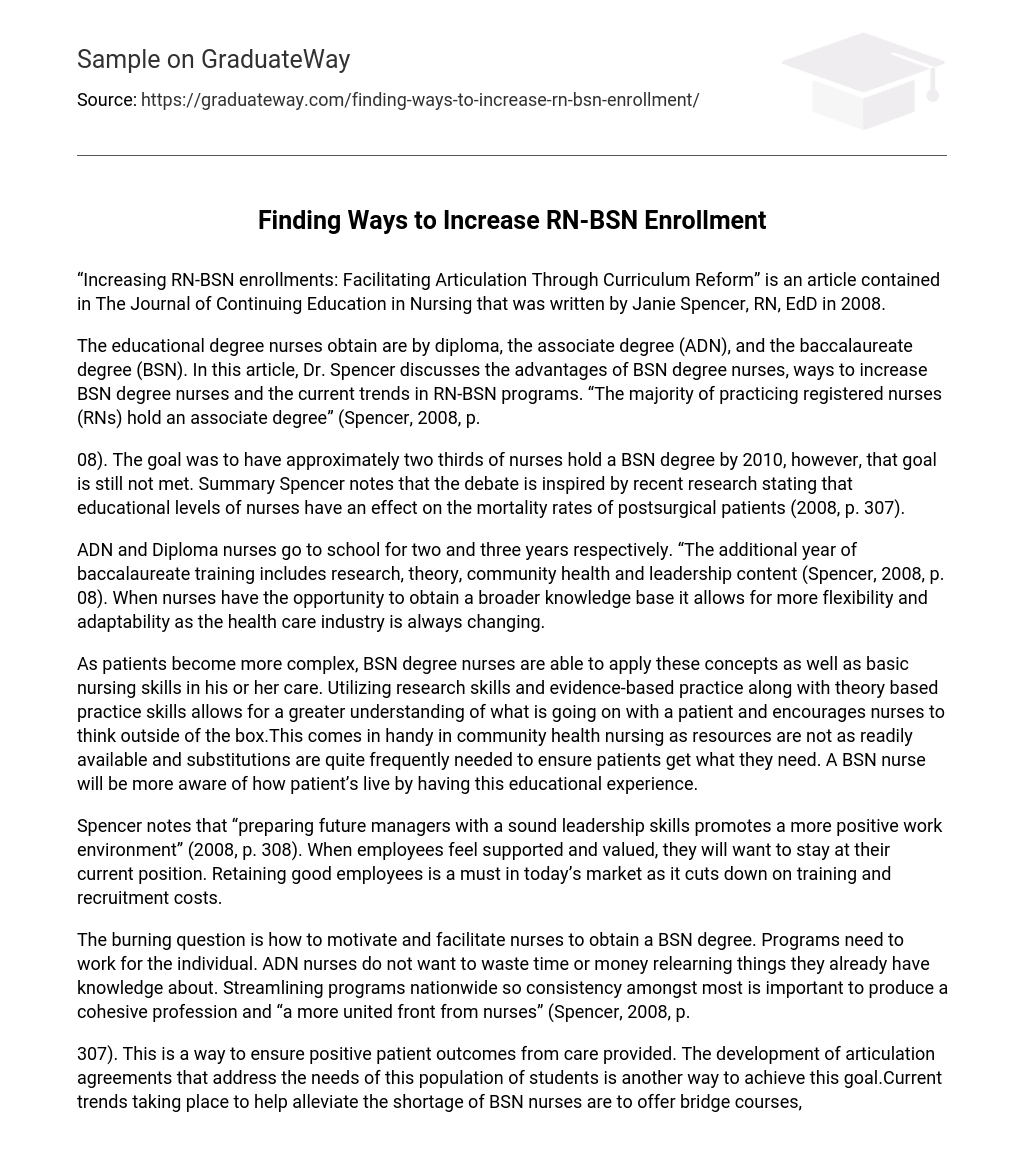“Increasing RN-BSN enrollments: Facilitating Articulation Through Curriculum Reform” is an article contained in The Journal of Continuing Education in Nursing that was written by Janie Spencer, RN, EdD in 2008.
The educational degree nurses obtain are by diploma, the associate degree (ADN), and the baccalaureate degree (BSN). In this article, Dr. Spencer discusses the advantages of BSN degree nurses, ways to increase BSN degree nurses and the current trends in RN-BSN programs. “The majority of practicing registered nurses (RNs) hold an associate degree” (Spencer, 2008, p.
08). The goal was to have approximately two thirds of nurses hold a BSN degree by 2010, however, that goal is still not met. Summary Spencer notes that the debate is inspired by recent research stating that educational levels of nurses have an effect on the mortality rates of postsurgical patients (2008, p. 307).
ADN and Diploma nurses go to school for two and three years respectively. “The additional year of baccalaureate training includes research, theory, community health and leadership content (Spencer, 2008, p. 08). When nurses have the opportunity to obtain a broader knowledge base it allows for more flexibility and adaptability as the health care industry is always changing.
As patients become more complex, BSN degree nurses are able to apply these concepts as well as basic nursing skills in his or her care. Utilizing research skills and evidence-based practice along with theory based practice skills allows for a greater understanding of what is going on with a patient and encourages nurses to think outside of the box.This comes in handy in community health nursing as resources are not as readily available and substitutions are quite frequently needed to ensure patients get what they need. A BSN nurse will be more aware of how patient’s live by having this educational experience.
Spencer notes that “preparing future managers with a sound leadership skills promotes a more positive work environment” (2008, p. 308). When employees feel supported and valued, they will want to stay at their current position. Retaining good employees is a must in today’s market as it cuts down on training and recruitment costs.
The burning question is how to motivate and facilitate nurses to obtain a BSN degree. Programs need to work for the individual. ADN nurses do not want to waste time or money relearning things they already have knowledge about. Streamlining programs nationwide so consistency amongst most is important to produce a cohesive profession and “a more united front from nurses” (Spencer, 2008, p.
307). This is a way to ensure positive patient outcomes from care provided. The development of articulation agreements that address the needs of this population of students is another way to achieve this goal.Current trends taking place to help alleviate the shortage of BSN nurses are to offer bridge courses, develop core courses for all programs to follow, have flexibility in course taking such as web based programs, eliminating prelicensure courses and develop service learning.
Using a collaborative approach where the nurse’s current place of employment is a perfect setting to incorporate the BSN education track. Conclusion To increase RN-BSN degree nurses, diverse solutions should be offered.Emphasizing advantages of gaining a higher education, continuing with the ADN programs, and establishing articulation agreements are ways to promote this growth. BSN degree nurses have the ability to apply a greater knowledge and skill to help promote positive patient outcomes.
ReferencesSpencer, J. (2008). Increasing RN-BSN Enrollments: Facilitating Articulation Through Curriculum Reform. The Journal of Continuing Education in Nursing, 39(7), 307-313.
Retrieved from http://web. ebscohost. com/ehost/pdfviewer/pdfviewer? vid=7&hid=8&sid=2b4a197c-b713-4bc7-ba61-0926fc5b10f3%40sessionmgr114





